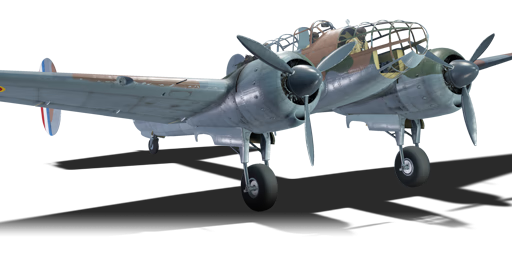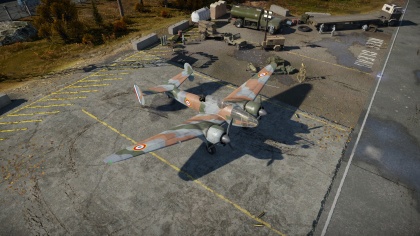Difference between revisions of "M.B.174A-3"
(Edits) |
(→Flight performance) |
||
| Line 9: | Line 9: | ||
== General info == | == General info == | ||
=== Flight performance === | === Flight performance === | ||
| − | ''Describe how the aircraft behaves in the air. Speed, manoeuvrability, acceleration and allowable loads - these are the most important characteristics of the vehicle.'' | + | <!--''Describe how the aircraft behaves in the air. Speed, manoeuvrability, acceleration and allowable loads - these are the most important characteristics of the vehicle.''--> |
{| class="wikitable" style="text-align:center" width="70%" | {| class="wikitable" style="text-align:center" width="70%" | ||
Revision as of 12:19, 20 October 2020
Contents
Description
The M.B.174A-3 is a rank I French bomber
with a battle rating of 2.0 (AB) and 2.7 (RB/SB). It was introduced in Update 1.73 "Vive la France".
General info
Flight performance
| Characteristics | Max Speed (km/h at 3,780 m) |
Max altitude (metres) |
Turn time (seconds) |
Rate of climb (metres/second) |
Take-off run (metres) | |||
|---|---|---|---|---|---|---|---|---|
| AB | RB | AB | RB | AB | RB | |||
| Stock | 511 | 497 | 10300 | 19.9 | 20.6 | 8.2 | 8.2 | 450 |
| Upgraded | 566 | 537 | 18.7 | 19.0 | 16.4 | 11.6 | ||
Details
| Features | ||||
|---|---|---|---|---|
| Combat flaps | Take-off flaps | Landing flaps | Air brakes | Arrestor gear |
| ✓ | ✓ | ✓ | X | X |
| Limits | ||||||
|---|---|---|---|---|---|---|
| Wings (km/h) | Gear (km/h) | Flaps (km/h) | Max Static G | |||
| Combat | Take-off | Landing | + | - | ||
| 680 | 280 | 340 | 300 | 260 | ~11 | ~5 |
| Optimal velocities (km/h) | |||
|---|---|---|---|
| Ailerons | Rudder | Elevators | Radiator |
| < 325 | < 200 | < 480 | > 180 |
Survivability and armour
- 8 mm Steel plate behind the pilot's head.
Armaments
Offensive armament
The M.B.174A-3 is armed with:
- 2 x 7.5 mm MAC 1934 machine guns, wing-mounted (500 rpg = 1,000 total)
The two machine guns are arranged with one mounted in each wing. Each is armed with the same amount of ammunition, which means that all guns will fire with each other until empty.
Suspended armament
The M.B.174A-3 can be outfitted with the following ordnance:
- 8 x 50 kg G.A. MMN. 50 bombs (400 kg total)
- 1 x 500 kg No.2 bomb (500 kg total)
Defensive armament
The M.B.174A-3 is defended by:
- 2 x 7.5 mm MAC 1934 machine guns, dorsal turret (400 rpg = 800 total)
- 3 x 7.5 mm MAC 1934 machine guns, ventral turret (500 rpg = 1,500 total)
Usage in battles
M.B.174 is rather manoeuvrable flying in a straight line since the aircraft can roll pretty well and has acceptable elevator motion. When in a combat situation, this changes considerable as the plane is difficult to handle in dives and turns. Trying to approach a bombing target in a diving turn, the M.B.174 is very slow to turn around and the bow keeps pointing way off the line of flight. Even using full rudder control, the bow of the plane just does not follow the turn, making it likely that the bombs will miss their target.
The 50 kg bombs are not effective against any ground targets so it is imperative to research the heavier loads immediately. In attack mode, the 7.5 mm MG don't make much of a dent on enemies, and since ammo runs out quickly, any attack must be carefully planned. In addition, the M.B.174 does not conserve energy well and trying to climb will reduce speed to under 200 km/h, in which case the pilot can expect to be toasted if there are enemies anywhere in the vicinity.
Tactics should be focused on bombing ground targets with a straight line approach and a clear exit away from the enemy. Attacking bombers at higher altitude is not advisable. Fighters busy in turn fights can be attacked if you have an altitude advantage and a line of exit. After bombing the target, by turning away from the enemy and decending at the same time you will probably be able either to outrun or keep up with most of the enemy fighters at this br.
Manual Engine Control
| MEC elements | ||||||
|---|---|---|---|---|---|---|
| Mixer | Pitch | Radiator | Supercharger | Turbocharger | ||
| Oil | Water | Type | ||||
| Controllable | Controllable Not auto controlled |
Not controllable Not auto controlled |
Controllable Not auto controlled |
Combined | Not controllable 1 gear |
Not controllable |
Modules
| Tier | Flight performance | Survivability | Weaponry | ||
|---|---|---|---|---|---|
| I | Fuselage repair | Radiator | Offensive 7 mm | ||
| II | Compressor | Airframe | New 7 mm MGs | 500 GPs | |
| III | Wings repair | Engine | Turret 7 mm | ||
| IV | Engine injection | Cover | New 7 mm MGs (turret) | ||
Pros and cons
Pros:
- Good speed for a bomber
- Extremely manoeuvrable for a bomber
- Has offensive armament, though weak, many bombers cannot say the same
Cons:
- Extremely weak payload
- Poor defensive armament
- Poor acceleration
- Need to use rudder heavily in diving turns
History
Evolution of the MB.170, this new model definitively abandoned the belly turret and the crew's typical layout was revised. The cockpit and front-end glazing were again modified, however, the MB.170-02's tail was retained. Intended specifically for reconnaissance with a secondary bombing mission, the prototype took the air on 5 January 1939 in Villacoublay piloted by René Le Bail with 14M-20/21 Gnome & Rhône engines of 1,030 hp. Six pre-production aircraft were ordered to activate the development of the twin-engine aircraft, but this aircraft proved to be very fast and easy to fly from the first tests, manoeuvrable even at very high altitude and an order for 50 serial copies was notified on 1 February 1939. Intended to replace the Potez 63.11 of the war, they were to receive 14M-48/49 Gnome & Rhône engines of 1,100 hp, but the first tests carried out with the pre-series aircraft revealed cooling problems. It was, therefore, necessary to reduce the diameter of the propeller pans in order to increase the airflow on the cylinder heads. Finally, just before the commissioning it was decided to increase the armament, which was finally attached to two 7.5 mm MAC 1934 machine guns in the wings and three mounted in removable ventral fairings pulling forward, a dorsal machine gun and a ventral weapon of the same type pulling backwards. The belly compartment allowed 400 kg of bombs to be carried, but in its initial version, its capacity was in fact limited to 8 x 40 kg bombs which was clearly insufficient in most operations. The production was launched in November 1939 at the SNCASO plant in Bordeaux-Mérignac, but because of the modifications made to the planes during their development the first 20 MB.174 were accepted by the air force only in February 1940 and put into service in March 1940 to the strategic reconnaissance group GR II/33. 56 copies were delivered until June 22, 1940. In operations, this twin-engine aircraft was able to outrun the best German fighters then in service and only 4 MB.174 were lost to the enemy during the Battle of France.
During Battle of France on May 1940, the famous French writer Antoine de Saint-Exupery flew a Bloch M. B 174 with the Groupe de reconnaissance II/33 in a squadron of Armée de l'Air. On 23rd May of 1940, he made a recon mission above the city of Arras during the German invasion and his plane was heavily damaged by Flak and attacked by fighters however he managed to get back at his airfield and save his crew. Due to this heroic action, he was awarded of Croix de Guerre (Iron Cross) on 2nd June 1940. This mission inspired him a book named Pilote de Guerre. (War Pilot)
Media
Excellent additions to the article would be video guides, screenshots from the game, and photos.
See also
Links to the articles on the War Thunder Wiki that you think will be useful for the reader, for example:
- reference to the series of the aircraft;
- links to approximate analogues of other nations and research trees.
External links
Paste links to sources and external resources, such as:
- topic on the official game forum;
- encyclopedia page on the aircraft;
- other literature.
Template:AirManufacturer Bloch
| France bombers | |
|---|---|
| Farman | F.222.2 · N.C.223.3 |
| Latécoère | Late 298D |
| Potez | Potez 633 |
| Liore et Olivier | LeO 451 early · LeO 451 late |
| Bloch | M.B.174A-3 · M.B.162 · M.B.175T |
| American | V-156-F · Martin 167-A3 · ▄A-35B · ▄SB2C-5 · B-26C · ▄PBY-5A Late · ▄PB4Y-2 |
| British | Lancaster MR.7 |





